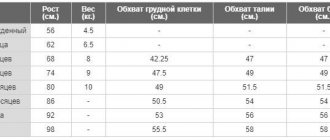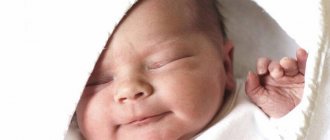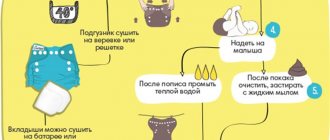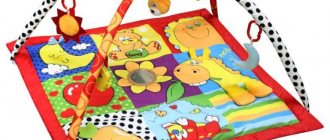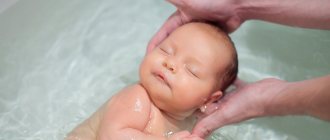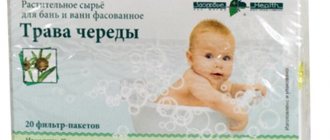08 October 2018
Averyanova Sveta
There are usually no problems with choosing shoes in a store with a child. Shoes are tried on until a pair that fits the feet is found. But if a mother wants to order shoes or sneakers through an online store or chooses a gift without the possibility of trying on, she will need a size chart of shoes for children. How not to make a mistake when buying shoes and how to choose the ideal option based on foot length and fullness, we will tell you in our article.
How to determine a child's shoe size
Shoe sizes for children are determined by foot length and fullness. They need to be measured at home. To obtain accurate data you will need a piece of paper, a pencil and a ruler. Proceed according to the following algorithm:

- First place the baby's right foot on the paper.
- Trace around with a pencil, pressing the lead firmly against the arch of your foot.
- Repeat the procedure with the left leg.
- Take a ruler.
- Using the resulting outline, measure the distance between the center of the heel and the tip of the big toe.
- Correlate the data obtained with the accepted system for determining the size of boots of the country of origin. The children's foot size chart will come to your aid.
- Remember to consider the fullness of the leg. Wide shoes are not suitable for thin feet. It is better to take one with laces, a lock, and for a full one - with Velcro to regulate the free space.

Size chart of booties and socks for newborns up to one year
The size of baby booties is determined by the length of the newborn's foot. Age by month is not taken into account here, since babies develop individually and grow very quickly. In accordance with the sizes of Europe and Russia, the following size chart is used.
You might be interested in: 5.5 month old baby: what a boy should be able to do
Bootie size chart USA, UK
European manufacturers usually use these parameters. These data can be used to determine the size of a month-old or one-year-old baby.
Most manufacturers indicate bootie sizes in centimeters. These numbers usually correspond to the length of a newborn's foot. For example, if a child’s foot is 10 cm long, his size will be 10.
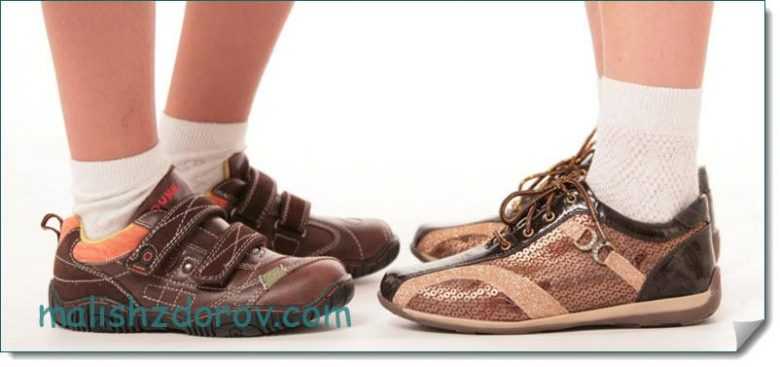
Manufacturers of Russian shoes and booties often use other standards. In such tables, dimensions were indicated in millimeters in 5 divisions. For example, if the table shows size 100, it corresponds to 100 millimeters, that is, 10 centimeters. Below you can see the size stack of Russia.
In addition, the letter size grid is popular. Below is an example.
When choosing baby booties for a boy or girl, you should know the length of your baby's feet. It must be compared with the manufacturer’s grid, since all brands of shoes and booties have their own tables.
You might be interested in reading an article on the topic of children's clothing sizes. All the information you need is here.
Useful tips
- In children aged 1 to 3 years, the foot grows quickly. Measure your feet every three months.
- For infants, take measurements in a sitting position, lying down with a tape measure; for older children - standing.
- The data will be accurate in the evening, when the foot increases from daytime load and slight swelling.
- For winter shoes, take measurements with socks on, for summer shoes - barefoot.
- Be sure to set the length of both feet. Right and left indicators may differ. This is the norm. But when buying boots, focus on large sizes.
- Add 0.5–1 cm to the resulting length for infants and children under 3 years old, 0.5 cm for teenagers. The extra space inside the boots is necessary for ventilation. This advice does not need to be taken into account when buying beach shoes with open toes and heels.
- Round the received data up to normal. If it turns out to be 16.2 cm, focus on the length of 16.5 cm, that is, Russian size 26.
Important! Adult children only need to calculate the size while standing. In this position, the body weight puts pressure on the leg, it increases by several millimeters or even 1 cm.
We also recommend that you watch this detailed video:
Shoe size: table for children by age in Russia
| Age | Size |
| From 3 months up to six months | 16; 16,5, 17 |
| From six months to 9 months. | 18; 19 |
| From 9 months up to a year | 19,5; 20 |
| From a year to a year and a half | 20-22 |
| From one and a half to 2 years | 22-23 |
| From 2 to 3 years | 23-25 |
| From 3 to 4 years | 25-26 |
| From 4 to 5 years | 26-28 |
| From 5 to 6 years | 28-30 |
| From 6 to 7 years | 30-31 |
| From 7 to 8 years | 31-32 |
| From 8 to 10 years | 33-35 |
For boys
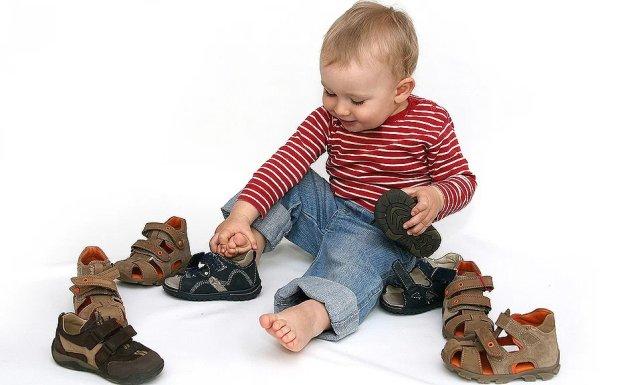
Boys have a different physical development than girls; their feet grow faster. Therefore, the size table looks like this:
| Boy, age | Size |
| From 3 months to six months | 16; 16,5; 17 |
| From six months to 9 months. | 18; 19 |
| From 9 months up to a year | 19,5; 20 |
| From 12 months up to 18 months | 21; 22 |
| From 2 to 3 years | 22,5 |
| From 4 to 5 years | 25,5; 26 |
| From 5 to 6 years | 28; 28,5 |
| From 6 to 8 years | 30; 31 |
| From 8 to 12 years | 33; 34; 35; 36 |
Sizing system in different countries
Children's shoes are produced all over the world, and size markings vary from country to country. This must be taken into account when purchasing boots of foreign and Russian production. Let's look at this in more detail:
- In Russia, Europe, China, and CIS countries, the system is metric. The basis is the length of the foot in millimeters. The size chart for these manufacturers is the same. The interval between values is 0.5 cm.
- In England, feet are measured in inches. 1 inch is equal to 2.54 cm. English shoes begin the size range from 0, then increase by 1/3 inch.
- France uses a stichmass system based on the stiches. 1 piece = 2/3 cm. The manufacturer measures not the foot, but the insole.
- In America, sizes can be determined by foot length, but in inches. The mesh shift is 1/12 inch, or 2.1 mm.
Tables of children's foot measurements from different countries
Each country offers its own measurement grid for children's feet. And in order to make an error-free purchase from foreign manufacturers, you should familiarize yourself with the size tables of the most popular countries exporting children's shoes.
Table for one-year-old children
| Centimeters | USA | England | Europe |
| 8,3 | 0,5 | 0 | 16 |
| 8,9 | 1 | 0,5 | 16 |
| 9,2 | 1,5 | 1 | 17 |
| 9,5 | 2 | 1 | 17 |
| 10,2 | 2,5 | 1,5 | 18 |
| 10,5 | 3 | 2 | 18 |
| 10,8 | 3,5 | 2,5 | 19 |
| 11,4 | 4 | 3 | 19 |
| 11,7 | 4,5 | 3,5 | 20 |
| 12,1 | 5 | 4 | 20 |
Table for children by age
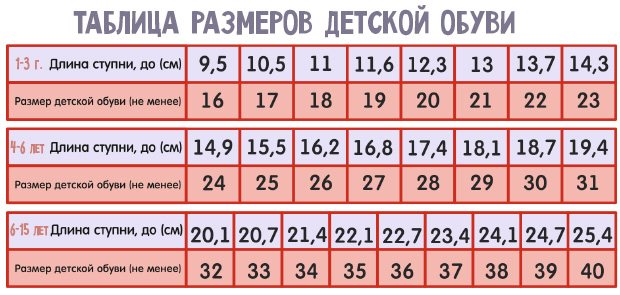
Shoe sizes for children by age are determined only approximately, but for orientation in stores and when ordering online, you can also use this table of ratios (Important! The table can be scrolled right and left on mobile devices):
| Child's age (girl) | Child's age (boy) | Foot length, cm (options) | Shoe size (Europe, Russia, China) |
| From 3 to 6 months | From 3 to 6 months | 9,5 | 16 |
| 10 | 16,5 | ||
| 10,5 | 17 | ||
| 6 to 9 months | 6 to 9 months | 11 | 18 |
| 11,5 | 19 | ||
| 9 to 12 months | 9 to 12 months | 12 | 19,5 |
| 12,5 | 20 | ||
| From a year to a year and a half | From a year to a year and a half | 13 | 21 |
| 13,5 | 22 | ||
| 2–3 years | 14 | 22,5 | |
| 1.5–2 years | 14,5 | 23 | |
| 15 | 24 | ||
| 2–3 years | 15,5 | 25 | |
| 4–5 years | 16 | 25,5 | |
| 16,5 | 26 | ||
| 3–4 years | 17 | 27 | |
| 4–5 years | 5–6 years | 17,5 | 28 |
| 18 | 28,5 | ||
| 5–6 years | 18,5 | 29 | |
| 6–8 years | 19 | 30 | |
| 19,5 | 31 | ||
| 6–7 years | 20 | 31,5 | |
| 20,5 | 32 | ||
| 8–12 years | 21 | 33 | |
| 21,5-22 | 34 | ||
| 22,5 | 35 | ||
| 23 | 36 |
Important! As can be seen from the table, girls' feet grow more slowly and are naturally smaller than boys' feet. Therefore, you also need to pay attention to gender and age.
American sizes. Table by age
Shoe sizes for children in America are also determined according to the length of the child's feet. But due to differences in measurement systems, American sizes are calculated by distance in inches.
| Age | Size (US) | Length in inches | Length in cm |
| 0-6 months | 0,5 | 3,25 | 8,3 |
| 1 | 3,5 | 8,9 | |
| 1,5 | 3,625 | 9,2 | |
| 2 | 3,75 | 9,5 | |
| 6-12 months | 2,5 | 4 | 10,2 |
| 3 | 4,125 | 10,5 | |
| 3,5 | 4,25 | 10,8 | |
| 4 | 4,5 | 11,4 | |
| 4,5 | 4,625 | 11,7 | |
| 5 | 4,75 | 12,1 | |
| 1-2 years | 5,5 | 5 | 12,7 |
| 6 | 5,125 | 13 | |
| 6,5 | 5,25 | 13,3 | |
| 7 | 5,5 | 14 | |
| 7,5 | 5,625 | 14,3 | |
| 2-3 years | 8 | 5,75 | 14,6 |
| 8,5 | 6 | 15,2 | |
| 9 | 6,125 | 15,6 | |
| 9,5 | 6,25 | 15,9 | |
| 4-5 years | 10 | 6,5 | 16,5 |
| 10,5 | 6,625 | 16,8 | |
| 11 | 6,75 | 17,1 | |
| 11,5 | 7 | 17,8 | |
| 6-7 years | 12 | 7,125 | 18,1 |
| 12,5 | 7,25 | 18,4 | |
| 13 | 7,5 | 19,1 | |
| 13,5 | 7,625 | 19,4 | |
| 8-9 years | 1 | 7,75 | 19,7 |
| 1,5 | 8 | 20,3 | |
| 2 | 8,125 | 20,6 | |
| 9-10 years | 2,5 | 8,25 | 21 |
| 3 | 8,5 | 21,6 | |
| 3,5 | 8,625 | 21,9 | |
| 12 years and older | 4 | 8,75 | 22,2 |
| 4,5 | 9 | 22,9 |
Size chart by foot length
The easiest way to select shoes is based on foot measurements taken at home in cm or mm. To simplify the translation of the size chart depending on the country of origin of the shoes, use the tables.
Size chart for children under one year old
| Foot length, cm | Russia/Europe | USA | Great Britain |
| 8,3 | 16 | 0,5 | 0 |
| 8,9 | 16 | 1 | 0,5 |
| 9,2 | 17 | 1,5 | 1 |
| 9,5 | 17 | 2 | 1 |
| 10,2 | 18 | 2,5 | 1,5 |
| 10,5 | 18 | 3 | 2 |
| 10,8 | 19 | 3,5 | 2,5 |
| 11,4 | 19 | 4 | 3 |
| 11,7 | 20 | 4,5 | 3,5 |
| 12,1 | 20 | 5 | 4 |
Table for children from 1 year to 5 years
| Foot length, cm | Russia/Europe | USA | Great Britain |
| 12,7 | 21 | 5,5 | 4,5 |
| 13 | 22 | 6 | 5 |
| 13,3 | 22 | 6,5 | 5,5 |
| 14 | 23 | 7 | 6 |
| 14,3 | 23 | 7,5 | 6,5 |
| 14,6 | 24 | 8 | 7 |
| 15,2 | 25 | 8,5 | 7,5 |
| 15,6 | 25 | 9 | 8 |
| 15,9 | 26 | 9,5 | 8,5 |
| 16,5 | 27 | 10 | 9 |
| 16,8 | 27 | 10,5 | 9,5 |
| 17,1 | 28 | 11 | 10 |
| 17,8 | 29 | 11,5 | 10,5 |
| 18,1 | 30 | 12 | 11 |
European sizes. Table by age
A child's foot size in centimeters by age in Europe, with the exception of the UK, is indicated by a single number. The English sizing system is based on the American model. The required size is calculated according to the length of the foot in cm.
| Age | Size Europe | Size England | Length, cm |
| 0-6 months | 16 | 0 | 8,3 |
| 16 | 0,5 | 8,9 | |
| 17 | 1 | 9,2 | |
| 17 | 1 | 9,5 | |
| 6-12 months | 18 | 1,5 | 10,2 |
| 18 | 2 | 10,5 | |
| 19 | 2,5 | 10,8 | |
| 19 | 3 | 11,4 | |
| 20 | 3,5 | 11,7 | |
| 20 | 4 | 12,2 | |
| 1-2 years | 21 | 4,5 | 12,7 |
| 22 | 5 | 13 | |
| 22 | 5,5 | 13,3 | |
| 23 | 6 | 14 | |
| 23 | 6,5 | 14,3 | |
| 2-3 years | 24 | 7 | 14,6 |
| 25 | 7,5 | 15,2 | |
| 25 | 8 | 15,6 | |
| 26 | 8,5 | 15,9 | |
| 4-5 years | 27 | 9 | 16,5 |
| 27 | 9,5 | 16,8 | |
| 28 | 10 | 17,1 | |
| 29 | 10,5 | 17,8 | |
| 6-7 years | 30 | 11 | 18,1 |
| 30 | 11,5 | 18,4 | |
| 31 | 12 | 19,1 | |
| 31 | 12,5 | 19,4 | |
| 8-9 years | 32 | 13 | 19,7 |
| 33 | 14 | 20,3 | |
| 33 | 1 | 20,6 | |
| 9-10 years | 34 | 1,5 | 21 |
| 34 | 2 | 21,6 | |
| 35 | 2,5 | 21,9 | |
| 12 years and older | 36 | 3 | 22,2 |
| 36 | 3,5 | 22,9 |
How to choose the size of shoes for a child
Unfortunately, not all manufacturers of children's shoes take into account and indicate the width of the shoes on the model. And this indicator is very important. Sandals, shoes and sneakers of the same size may be too tight or too loose for your baby. It all depends on the fullness of the leg.
In European countries, the letters C, D, E and others are indicated next to the size on the sole or on a special label. What do they mean? This is a criterion for the narrowness and width of the boots. You can decipher them like this:
- C – the narrowest shoes possible, for very, very thin feet.
- D – slightly wider than C. For very thin feet.
- E – shoes for narrow feet.
- F – average width.
- G – width slightly above average.
- N – wide shoes.
Important! If there are no markings for narrowness and width, then it is suitable for the average foot.
The completeness of the leg can be obtained in numbers and this data can be used to order through online resources. Use the formula:
P (fullness of the foot) = 0.25 O (circumference of the foot at the widest point) – 0.15 D ( length of the foot from heel to toes) – 16.5
This is interesting! American shoes are usually wider than Chinese, European and Russian ones. This is due to national physiological characteristics.
Table for determining a boy's shoe size
Can't find a shoe size for a 6-7 year old boy? It is worth using a special table. We can talk about any other age, for example, a shoe size of one and a half or two years for a boy, taking into account the age and length of the foot. Just find the appropriate value: for example, the shoe size for a 1.5-2 year old boy will be approximately 20-23 according to the European system and 5.5-7 according to the American system.
For example, let’s calculate the shoe size for a 3-year-old boy. We already know the age, we also need to know the length of the foot in inches and centimeters - 6.3 and 16, respectively. According to the table, we get size 26 according to the European system, which we use in modern life. If we translate this value into the American system, we will get a size in the range of 9-9.5. Of course, parents should understand that the values offered by any table will always be averaged.
| Age | Foot length | US size | European size | |
| Inches | Centimeters | |||
| 0-3 months | 3,7 | 9,5 | 0-2 | 16-17 |
| 0-6 months | 4,1 | 10,5 | 2,5-3,5 | 17-18 |
| 6-12 months | 4,6 | 11,7 | 4-4,5 | 19 |
| 12-18 months | 4,9 | 12,5 | 5-5,5 | 20 |
| 18-24 months | 5,2 | 13,4 | 6-6,5 | 21-22 |
| 2 years | 5,6 | 14,3 | 7 | 23 |
| 2.5 years | 5,8 | 14,7 | 7,5-8 | 24 |
| 2.5-3 years | 6 | 15,2 | 8-8,5 | 25 |
| 3-3.5 years | 6,3 | 16 | 9-9,5 | 26 |
| 4 years | 6,7 | 17,3 | 10-10,5 | 27 |
| 4-4.5 years | 6,9 | 17,6 | 11-11,5 | 28 |
| 5 years | 7,2 | 18,4 | 12 | 29 |
How to choose your first shoes
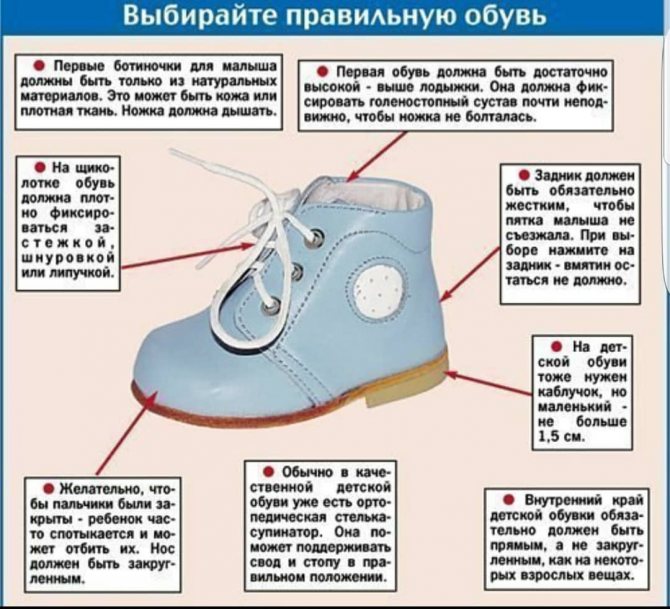
Proper footwear for infants and children under 1.5 years old must meet certain standards:
- The boots have two or three fasteners to secure the foot. For newborns and infants, choose Velcro to adjust the width of the internal cavity depending on the thickness of the sock you are wearing.
- A rigid high heel, even for summer sandals, is a must.
- Round toe without points or bulges. This is convenient and safe for a toddler who is just learning to walk.
- In any pair of shoes, leave a margin of 0.5 to 1 cm for freedom of the toes.
- You can't take shoes to grow into. This makes walking difficult and the baby loses balance.
- Find out the size of your child's feet while lying down as an infant, recheck every three months.
- Consider the rise of your feet. For infants, do not buy boots that are too high.
- Take the weather outside into account. Infants do not need to take warm boots for a warm spring. It is more convenient for them to run in sneakers or leather shoes with low sides.
Important! You can't wear shoes all the time. Be sure to take your child off his shoes at home so he can walk barefoot on hard floors, sand and earth. This is a good massage and prevention of flat feet.
Child's foot size chart
The sizing chart is a useful cheat sheet for adults when they need to know the size of a child’s feet in order to choose new shoes, sandals, boots, etc. The information is needed by handicraft girls who were asked to knit booties for a baby.
Each baby has a different size foot; there are newborns with a foot length of 7 cm. Knowing this parameter, you can calculate the required size, even if the baby’s limb differs from the standard dimensions for his age. The table contains all the main types of sizes presented in domestic stores; it won’t be difficult to figure it out.
| Time from baby's birth | Measurement result | Size in Russia and Europe | American dimension | |
| cm | inches | |||
| Up to 3 months | 9.5 | 3.7 | 16-17 | 0-2 |
| 3-6 m. | 10.5 | 4.1 | 17-18 | 2.5 – 3.5 |
| 6 months – 1 year | 11.7 | 4.6 | 18-19 | 4-4.5 |
| A year and a half | 12.5 | 4.9 | 19-20 | 5 – 5.5 |
| 18-24 months | 13.4 | 5.2 | 21-22 | 6 – 6.5 |
| 2 years | 14.3 | 5.6 | 23 | 7 |
| 2.5 – 3 g. | 15.2 | 6 | 25 | 8 – 8.5 |
| Up to 3.5 years | 16 | 6.3 | 29 | 9.5 |
| 4 years | 17.3 | 6.7 | 27 | 10 – 10.5 |
| 5 l. | 18.4 | 7.2 | 29 | 12 |
How to tell if shoes are too small
Finding out that boots or closed shoes are too small is difficult if the child does not speak yet, cannot complain about tightness in the fingers, or pain when walking. In this case, the mother needs to act like this:
- After going outside, carefully examine your baby's feet. If there are red spots on the heel or toes, or pain is felt, then it’s time to change the shoes.
- Put your child's shoes on and press the toe in the big toe area with your hands. There should be some space left. If the tops are suitable in width and size, there will be free space and your finger will not rest on the edge.
- Inspect the boots. A stretched surface and bubbles on the backs indicate tightness.
- Find out if there is any free space between the foot and the tongue.
Try putting your finger under the tongue. If it doesn't fit, change your shoes. They are not the right size or fullness.
How to choose
The sizing of shoe products from manufacturers from different countries may differ. To choose the most suitable product, you need to understand the designation systems.
The most common of them:
- metric;
- inch;
- shtihmasovaya.
The metric (Russian) system has symbols in centimeters, its features are described above.
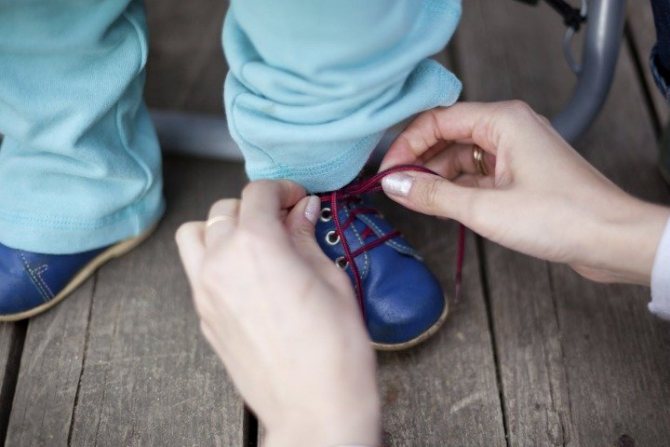
The inch (English) length uses the British as well as the American length - 1 inch (about 2.5 cm). In addition, it divides the children's shoe size grid into two age categories: 0 - 6 years (Toddler), 6 - 16 years (Kid). The starting point for this system is the foot length of newborns, which is 4 inches (approximately 10 cm) and has a size of 0 or 1. Subsequent values increase by 1/3 inch (about 8.5 mm).
The stichmas or European system is based on the ancient French measure - the stich. 1 piece is equal to 6.67 mm or 2/3 cm. Different manufacturers take into account a decorative allowance of 5-15 mm.
What material to choose shoes from?
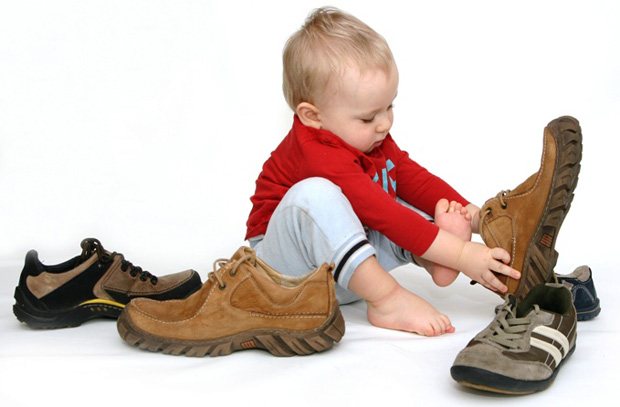
Shoe material is very important for young children.
What to look for when choosing boots made from different raw materials:
- The material must be breathable. In rubber boots, your feet sweat, but in leather shoes and textile sneakers, the skin breathes and does not overheat.
- Hypoallergenic. This is an indicator of quality. Leather, latex, felt, suede are suitable for allergy sufferers. Low-quality rubber and natural felt can cause unpleasant reactions.
- Smell. Smell the shoes, sneakers. If they smell unpleasant, repulsive, then you shouldn’t buy them.
- Rigidity. Textile shoes wear out quickly, the fabric bubbles and becomes deformed. This negatively affects the formation of the ankle. Shoes made of genuine leather are worn, maintaining their appearance for a long time, without causing harm to the gait and foot of the child.
An approximate list of models and materials is given in the table (Important! The table can be scrolled right and left on mobile devices):
| Material | Advantages and disadvantages | Models | What time of year is it suitable for? |
| Genuine Leather | • Does not get wet • Does not deform • Breathes • Long lasting • Looks aesthetically pleasing • Safe for babies • High price | Shoes, boots, shoes, sneakers, sandals | All year round |
| Eco leather | • Cheap • Beautiful • Wears out in one season | Shoes, sandals | Summer |
| Suede | • Natural material • Easily deformed • Gets wet • Worn out from wear | Spring, autumn boots, shoes | Cold summer, early autumn and spring |
| Lightweight fabric (jeans, linen, cotton) | • Lightweight shoes • Breathable material • Low price • Hypoallergenic material • Not recommended for two-year-old children and infants for long-term wear | Sneakers, slippers | Summer, late spring |
| Dense warm material (felt, felt) | • Keeps out the cold • Easy to wear for babies • Breathable • Waterproof | Felt boots, warm boots | Winter |
| Rubber, latex | • Wear-resistant • Waterproof • Does not heat feet | Boots, flip flops, beach shoes, sandals | Autumn, summer |
Size range of various manufacturers
To select shoes, sneakers and sandals from various brands, manufacturers recommend using special nets that their company provides. Below you can find tables of popular brands of children's shoes.
Kotofey
This brand produces sneakers and trainers for children of all ages. It is distinguished by convenience and quality.
You might be interested in: How tall should a girl be at 12 years old?

Crocs
produces both fashionable and comfortable shoes for children of all ages. The company uses a special material – Croslite – in the production of winter and demi-season products. Thanks to it, the shoes accept and maintain the body temperature of the baby’s feet, which is its undoubted advantage. Crocs can be chosen for a boy or a girl in accordance with the following table.
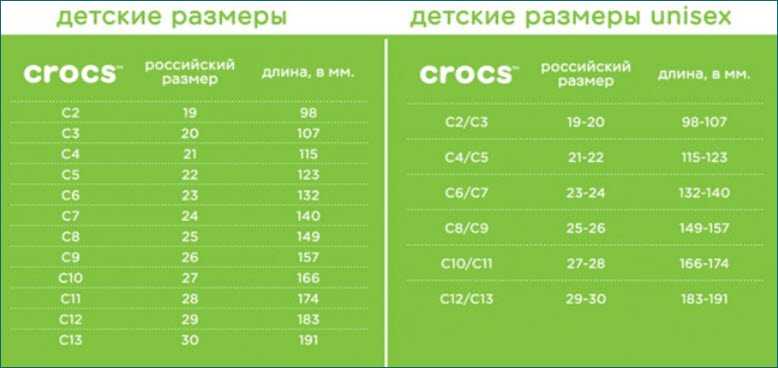
Adidas
Few parents have not heard of such a popular brand as Adidas. The company has held a strong position in the global market for decades. Their products are popular in all countries. The size scale is below.
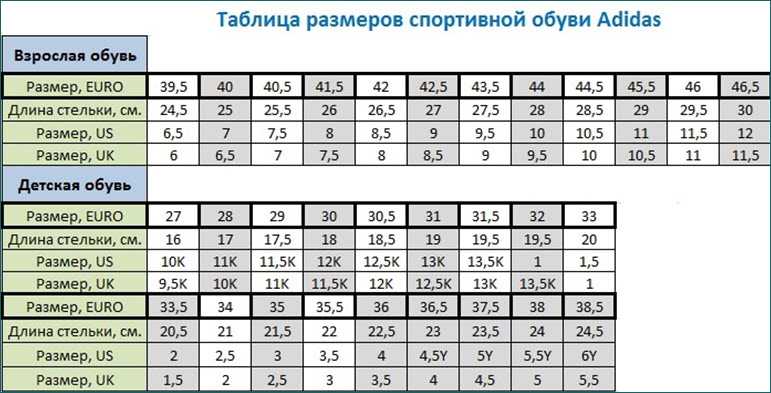
Skorokhod
The Russian company produces children's shoes for various ages. Boots, sneakers, sandals and shoes of this brand are environmentally friendly and of excellent quality. To select shoes for children from 6 to 12-14 years old, you should use the following table of correspondence between the metric and weight systems.
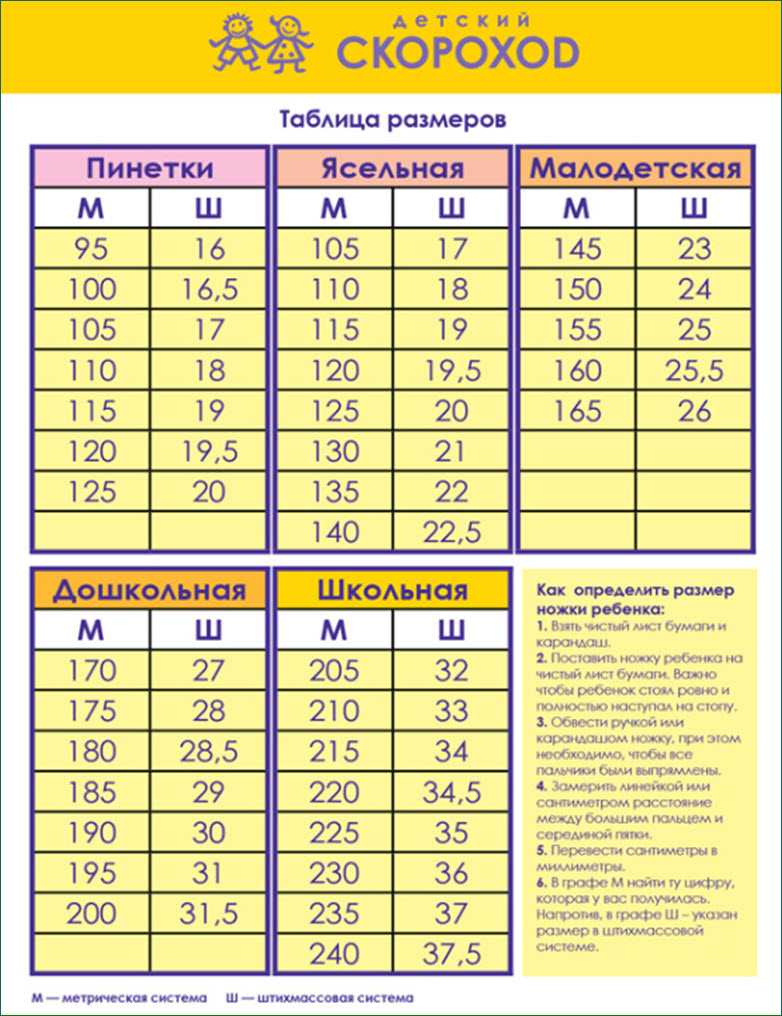
Fairy tale
Reviews from many parents indicate that shoes from the Skazka brand are at least one size larger. To choose the most comfortable shoes and boots, you should use the sizing chart of this particular company. You can find it below.
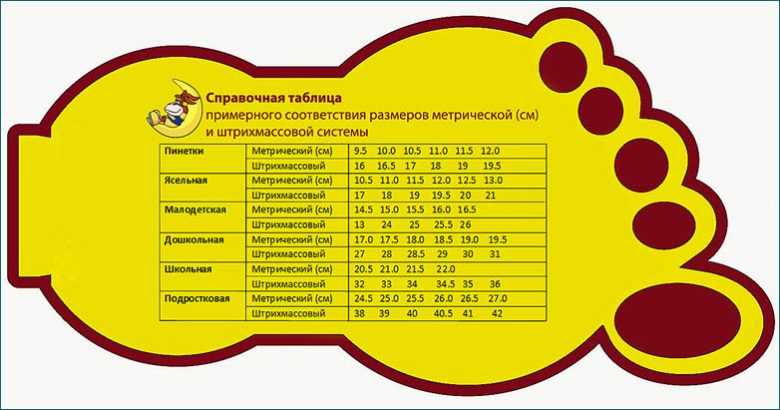
Nike
The sports company Nike offers a wide selection of shoes for adults, teenagers and children. To select sneakers, sandals and sneakers, you should use a special table.
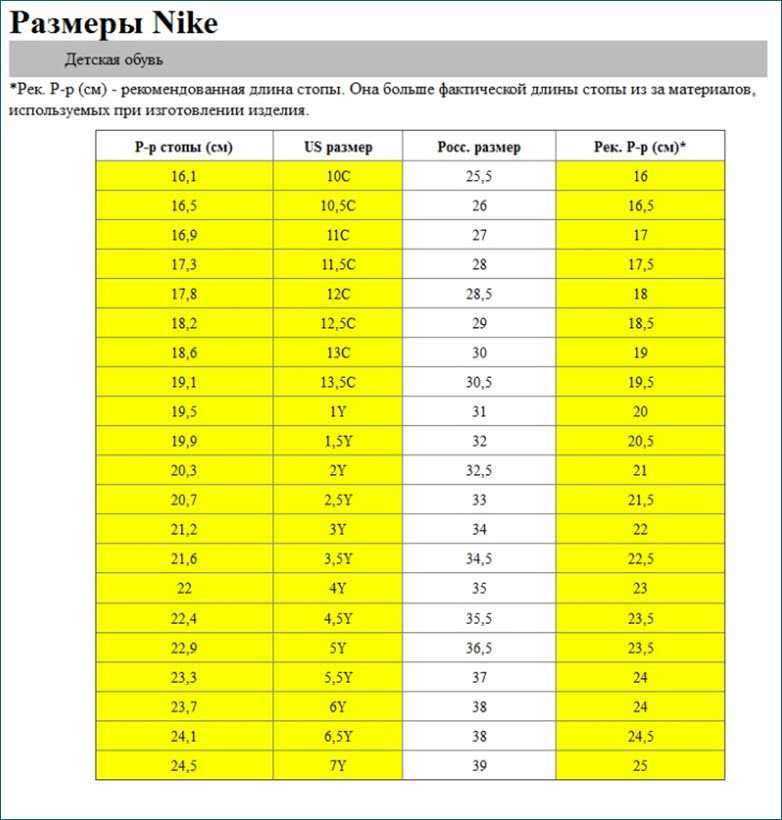
Ekko
The international company Ecco is a reliable manufacturer of adult and children's shoes. Its products have conquered the whole world and for many years the brand has not given up its position. The Ecco size scale is provided below.
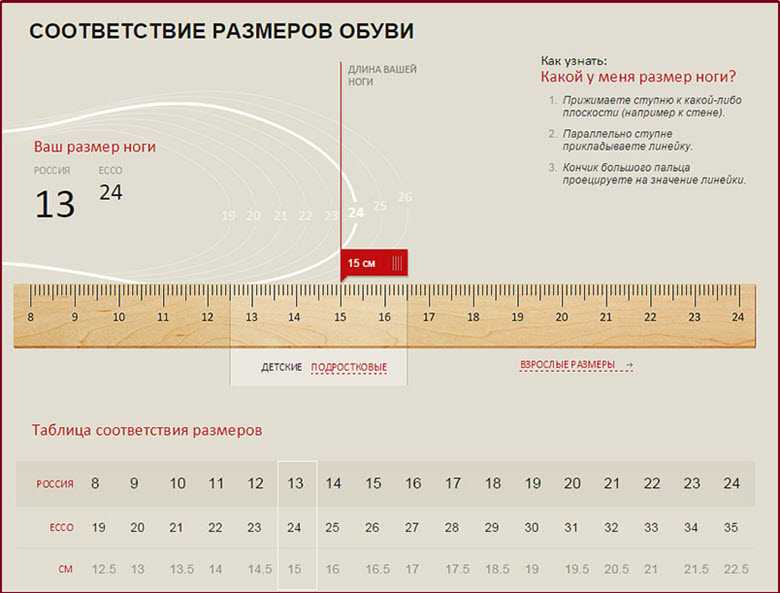
Zebra
offers parents high-quality and environmentally friendly shoes. To create it, special technologies are used to make comfortable shoes, sandals, and sneakers for children. Below is the size chart.

It is impossible to say for sure which manufacturer is better. Parents should select shoes for their child, taking into account the individual characteristics of their son or daughter, and also taking into account the pricing policy of a particular company.
You might be interested in: What a baby should be able to do at 8 months (girl)
Size charts of common brands
Fans of global brands will find it useful to use tables of correspondence between Russian shoe sizes, manufacturer markings and foot length. All that remains is to try on your feet and buy the shoes you need from the catalog through the online store.
AliExpress (“Aliexpress”)
On this trading platform, the size corresponds to the foot length of a child and an adult. That is, how many centimeters is the leg, buy that size. A very convenient system for Russian consumers.
| Foot length, cm | 9,5 | 10 | 10,5 | 11 | 11,5 | 12 | 12,5 | 13 | 13,5 |
| Size on the seller's website | 9,5 | 10 | 10,5 | 11 | 11,5 | 12 | 12,5 | 13 | 13,5 |
"Kotofey"
Not too expensive children's shoes for all seasons are made from natural high-quality materials.
The manufacturer produces boots and sandals for children of any age. Products are divided into groups by age.
"Kapika"
This brand is responsible for shoes in the off-season and cold weather. "Kapika" offers a wide selection of rubber boots, dutik, galoshes. Choose your size according to the grid. It is the same for “Kotofey”.
| Age group | |||||||||
| Booties | Foot length, cm | 9,5 | 10 | 10,5 | 11 | 11,5 | 12 | 12,5 | |
| Shoe size | 16 | 16,5 | 17 | 18 | 19 | 19,5 | 20 | ||
| From 1 year to 3 years (nursery) | Foot length, cm | 10,5 | 11 | 11,5 | 12 | 12,5 | 13 | 13,5 | 14 |
| Shoe size | 17 | 18 | 19 | 19,5 | 20 | 21 | 22 | 22,5 | |
| Young children From 3 to 6 years | Foot length, cm | 14,5 | 15 | 15,5 | 16,5 | ||||
| Shoe size | 23 | 24 | 25 | 25,5 | 26 | ||||
| Preschool | Foot length, cm | 17 | 17,5 | 18 | 18,5 | 19 | 19,5 | 20 | |
| Shoe size | 27 | 28 | 28,5 | 29 | 30 | 31 | 31,5 | ||
| School (from 7 to 10–12 years) | Foot length, cm | 20,5 | 21 | 21,5 | 22 | 22,5 | 23 | 23,5 | 24 |
| Shoe size | 32 | 33 | 34 | 34,5 | 35 | 36 | 37 | 37,5 | |
| Teenage | Foot length, cm | 24,5 | 25 | 25,5 | 26 | 26,5 | 27 | 27,5 | 28 |
| Shoe size | 38 | 39 | 40 | 40,5 | 41 | 42 | 43 | 43,5 |
Adidas (“Adidas”)
Produces high quality sports and casual shoes. You can choose a model for children by correlating the length of the foot and the usual leg sizes with the English measure.
| Age group | Foot length, cm | Size (Russia, Europe) | Size (UK) |
| From 1 year to 3 years | 11,4 | 19 | 3K |
| 12,2 | 20 | 4K | |
| 13,1 | 21 | 5K | |
| 13,6 | 22 | 5.5K | |
| 13,9 | 23 | 6K | |
| 14,6 | 24 | 7K | |
| 15,1 | 25 | 7.5K | |
| 15,9 | 26 | 8.5K | |
| 16,9 | 27 | 9.5K | |
| From 4 to 8 years | 17,1 | 28 | 10K |
| 18,3 | 29 | 11K | |
| 18,5 | 30 | 11.5K | |
| 19,1 | 31 | 12.5K | |
| 20 | 32 | 13,5 | |
| 20,6 | 33 | 1 | |
| 21,1 | 34 | 2 | |
| 21,6 | 35 | 2,5 | |
| From 9 to 12 years | 22,7 | — | 3 |
| 23 | 35 | 3,5 | |
| 23,3 | 35,5 | 4 | |
| 23,9 | 36 | 4,5 | |
| 24,3 | 36,5 | 5 | |
| 24,9 | 37 | 5,5 | |
| 25,2 | 38 | 6 | |
| 25,9 | 38,5 | 6,5 |
Nike
The manufacturer successfully combines price and quality of goods. That's why it's so popular with customers. Use the table to select your shoe size.
| Age | Foot length, cm | 8,3 | 9,1 | 10 | 10,8 | 11,6 | 12,5 | 13,3 | 14,2 | 15 | 15,9 | 16,7 | 17,2 | 17,6 | 18 | 18,4 | 18,8 | 19,3 | 19,7 |
| Children | Size, Russia | 14 | 15 | 16 | 17,5 | 18,5 | 20 | 21 | 22,5 | 24 | 25 | 26 | 26,5 | 27 | 27,5 | 28,5 | 29 | 30 | 30,5 |
| US size | 0C | 1C | 2C | 3C | 4C | 5C | 6C | 7C | 8C | 9C | 10C | 10.5C | 11C | 11.5C | 12C | 12.5C | 13C | 13.5C | |
| Teenagers | Length, feet, cm | 20,1 | 20,4 | 20,8 | 21,2 | 21,6 | 21,9 | 22,3 | 22,7 | 23,1 | 23,4 | 23,8 | 24,2 | 24,6 | |||||
| Size, Russia | 32 | 33 | 33,5 | 34 | 35 | 35,5 | 36 | 36,5 | 37,5 | 38 | 38,5 | 39 | 40 | ||||||
| Size, England | 13,5 | 1 | 1,5 | 2 | 2,5 | 3 | 3,5 | 4 | 4,5 | 5 | 5,5 | 6 | 6 |
"Fairy tale"
Produces comfortable shoes and boots for boys and girls from 0 to 12 years.
| Insole length, cm | 9,5 | 10 | 10,5 | 11 | 11,5 | 12,5 | 13 | 13,5 | 14,5 | 15 | 15,5 | 16,5 | 17 | 17,5 | 18 | 19 |
| Size | 16 | 16,5 | 17 | 18 | 19 | 20 | 21 | 22 | 23 | 24 | 25 | 26 | 27 | 28 | 29 | 30 |
A table that will help determine the size of a child's foot by age
A newborn baby, like a month-old baby, does not need shoes - maximum warm booties or socks. When the leg grows and the baby makes his first attempts to walk on his own, the need for his first shoes arises.
In order for the leg to develop correctly, it is necessary to select the appropriate shoe size. So, children's shoes should not be too big or small - because of this, the baby's foot will be deformed. It should be remembered that you cannot save on shoes that a child will wear, which means you should not buy shoes with the expectation of lasting several seasons. The following table will help you determine how many centimeters your child’s feet have:
| Child's age (girl) | Shoe size | |
| Metric grid (cm) | Stamp mesh (standard size) | |
| 3-6 months | 9,5/10/10,5 | 16/16,5/17 |
| 6-9 months | 11/11,5 | 18/19 |
| 9-12 months | 12/12,5 | 19,5/20 |
| 1-1.5 years | 13/13,5 | 21/22 |
| 2-3 years | 14 | 22,5 |
| 4-5 years | 16/16,5 | 25,5/26 |
| 5-6 years | 17,5/18 | 28/28,5 |
| 6-8 years | 19/19,5 | 30/31 |
| From 8 years | 21/21,5/22/22,5/23 | 33/34/34,5/35/36 |
The table for boys has some differences:
| Child's age (boy) | Shoe size | |
| Metric grid (cm) | Stamp mesh (standard size) | |
| 3-6 months | 9,5/10/10,5 | 16/16,5/17 |
| 6-9 months | 11/11,5 | 18/19 |
| 9-12 months | 12/12,5 | 19,5/20 |
| 1-1.5 years | 13/13,5/14 | 21/22/22,5 |
| 1.5-2 years | 14,5/15 | 23/24 |
| 2-3 years | 15,5/16/16,5 | 25/25,5/26 |
| 3-4 years | 17 | 27 |
| 4-5 years | 17,5/18 | 28/28,5 |
| 5-6 years | 18,5/19/19,5 | 29/30/31 |
| 6-7 years | 20/20,5/21 | 31,5/32/33 |
| From 7 years | 21,5/22/22,5/23 | 34/34,5/35/36 |
Bootie size chart USA, UK
| US size | 0,5 | 1 | 1,5 | 2 | 2,5 | 3 |
| Size, England | 0,5 | 1 | 1,5 | 2 | ||
| Foot length in cm | 8,3 | 8,9 | 9,2 | 9,5 | 10,2 | 10,5 |
| US size | 3,5 | 4 | 4,5 | 5 | 5,5 | 6 |
| Size, England | 2,5 | 3 | 3,5 | 4 | 4,5 | 5 |
| Foot length in cm | 10,8 | 11,4 | 11,7 | 12 | 12,7 | 13 |
Many manufacturers indicate the size of booties in centimeters, corresponding to the size of a newborn’s foot. So sizes 10, 11, 12, 13 correspond to foot lengths of 10 cm, 11 cm, 12 cm, 13 cm.
Previously, according to the Russian standard, the sizes of children's shoes and booties were indicated in millimeters with a size grid every 5 mm. Until now, some Russian manufacturers adhere to these designations. Russian size 100 means foot length 100 mm = 10 cm. For clarity, here is a table of Russian sizes of booties.
Correspondence of Russian sizes to foot length
Throughout the entire period of growth and maturation of a child, parents often encounter the need to determine the size of their child’s feet. Whether it's shopping or ordering online, it's best to know your shoe size in advance. There are special tables that will help you decide. These measurements are universal for Russian manufacturers.
| Foot length, cm | Size | Foot length, cm | Size |
| 9,5 | 16 | 17 | 27 |
| 10 | 16,5 | 17,5 | 28 |
| 10,5 | 17 | 18 | 28,5 |
| 11 | 18 | 18,5 | 29 |
| 11,5 | 19 | 19 | 30 |
| 12 | 19,5 | 19,5 | 31 |
| 12,5 | 20 | 20 | 31,5 |
| 13 | 21 | 20,5 | 32 |
| 13,5 | 22 | 21 | 33 |
| 14 | 22,5 | 21,5 | 34 |
| 14,5 | 23 | 22 | 34,5 |
| 15 | 24 | 22,5 | 35 |
| 15,5 | 25 | 23 | 36 |
| 16 | 25,5 | 23,5 | 37 |
| 16,5 | 26 |
We measure with a centimeter
The easiest and most affordable option to find out the size of your child’s feet is to use a measuring tape. There are three ways:
- Take a piece of paper and place your child on it. Use a pencil to outline the child's foot. Cut out the print and apply it to your chosen shoes in the store.
- You can wet the foot and place the baby on a piece of paper. The remaining trace is measured with a centimeter.
- At an early age, children's legs are measured with a centimeter, tape measure or thread. Afterwards, the resulting length of the thread is measured using a ruler. When the baby is already standing on his own, you can measure the leg in a standing position.
Don't limit yourself to one foot, you need to measure two, because the length of the feet may vary slightly up or down. The measurement that is larger is considered correct. So, the shoes will not press.
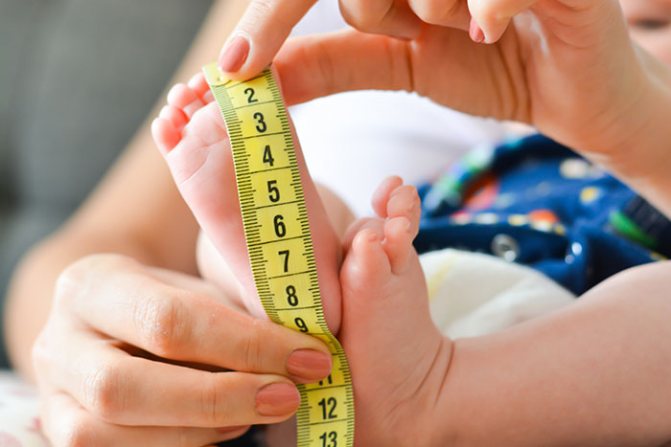
After the measurements are taken, you need to add 0.5 cm to the result obtained if you are choosing shoes for the summer, and 1.5 cm if you are buying winter ones. So, boots for the winter will not be too tight in a warm sock and will not be too big. In addition, in shoes with a small margin, air circulates better and the heat lasts longer.
Foot size according to age can be found out using specially designed tables, which are presented below.
How to choose product completeness
Products of different thicknesses are produced for one size. This indicator is marked on the sole or on a special label. Turning the shoes over, you can see the designations next to the size on the sole: numbers from 1 to 12 with a step of 4 mm in Russia or Latin letters on foreign models with a difference of 3.5 mm.
| Completeness | In Europe | In other countries |
| Narrow | N | D |
| Average | M | E |
| Wide | X | F |
| Very wide | XW | G |
| Extra wide | XXW | H |
In European countries, another indicator is used - C. This is how very narrow shoes are determined. If there is no numerical or letter designation next to the size, then this indicates that the product is made to an average parameter. It is determined by the formula: W = 0.25 x B – 0.15 x C – A, where:
- W – completeness indicator;
- B – foot circumference;
- C – foot length;
- A – coefficient.
The value of A varies depending on age. The coefficient for infants is 20, for toddlers and preschoolers – 16.5, for schoolchildren – 13.5. Calculations are carried out in millimeters. Branded shoes fit 90 percent of children. As a last resort, minor deviations in the rise of the leg can always be adjusted with fasteners or laces.
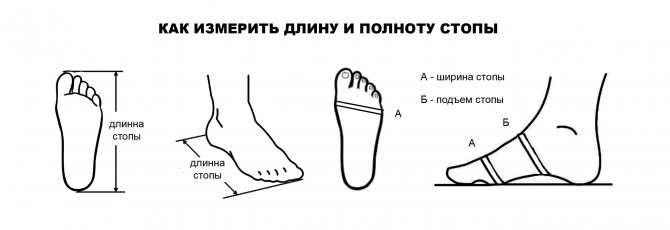
Leg fullness measurement
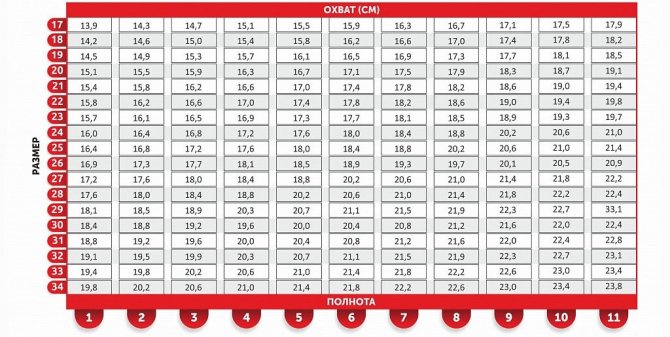
Shoe size chart
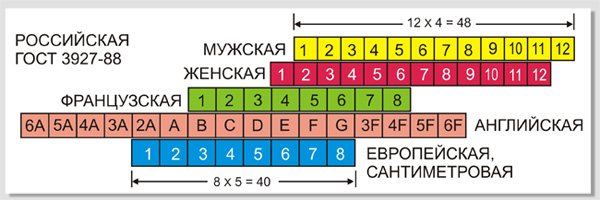
Correlation of full scales of different shoe numbering systems
How to find out your child's shoe size
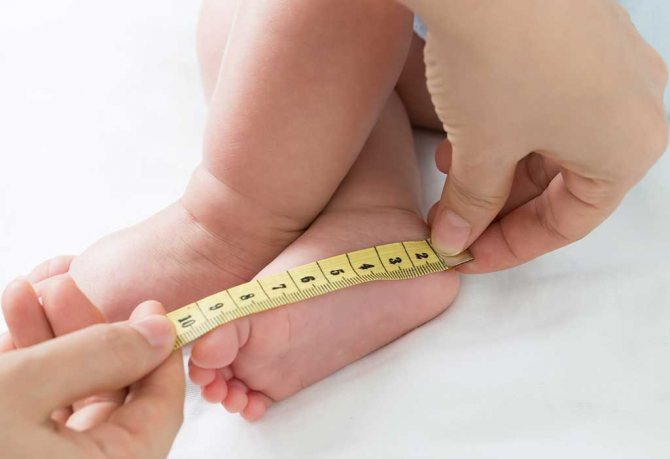
Let's look at the basic method of measuring the foot. There is a simple algorithm of actions that will help you easily determine the size of a baby who can confidently stand on his feet:
- You will need a piece of paper, a ruler and a pencil.
- It is necessary to place the child’s foot on the sheet and trace the outline of the foot. The baby should lean on exactly the leg that is being measured.
- Using a ruler, measure the distance from the midpoint on the heel to the top of the longest toe.
- You need to do the same with the other leg. It is important not to miss this point, since the size of one leg from another may differ by up to 0.5 cm. In this case, you must select the largest value.
- Using the manufacturer's size chart, the required one is determined in accordance with the resulting measurement result.
This method allows you to determine the size of children's shoes based on the length of the foot. Fortunately, he is not the only one. There is another way in which you can determine the size by the insole of children's shoes. This approach does not use a table. In our country, children's shoe sizes are not measured in centimeters. For this, a shtichmass system is used, where the units are taken not as a centimeter, but as a shtik, equal to 2/3 of a centimeter. First of all, you need to take the length of the foot and add 1 cm to get the length of the insole. Next, the result obtained is divided by 2 and multiplied by 3. The desired size is obtained.
For example, a baby’s leg is 13 cm. We make calculations: (13+1)/2*3=21. The required size for a leg 13 cm long is 21. We check it with the table, everything is correct. Here's how to determine the size of children's shoes correctly.
If the baby does not yet walk, the foot is measured in a lying position with a ruler. You can round the result up.
Today, there are special devices for measuring feet; such assistants will certainly make it easier for parents to choose the size.

American children's shoe size chart
You can choose the right shoe size made in the USA using the correspondence table for children from 1 to 6 years old. The first column is the child's foot length, the second is the approximate age and the last column is the US shoe size.
| Foot length (in cm) | Child's age | US size |
| 12,7 | 1-1.5 years | 5,5 |
| 13 | 6 | |
| 13,3 | 6,5 | |
| 14 | 7 | |
| 14,3 | 7,5 | |
| 14,6 | 2 years | 8 |
| 15,2 | 8,5 | |
| 15,6 | 9 | |
| 15,9 | 3 years | 9,5 |
| 16,5 | 10 | |
| 16,8 | 10,5 | |
| 17,1 | 4 years | 11 |
| 17,8 | 11,5 | |
| 18,1 | 5 years | 12 |
| 18,4 | 12,5 | |
| 19,1 | 6 years | 13 |
| 19,4 | 13,5 |
Shoes for children made in the USA in the size range differ significantly from Russian manufacturers. American sizes of children's shoes are conventionally divided into three groups: * sizes from 0.5 to 5 (for infants up to one year); * sizes from 6 to 13.5 (for children from 1.5 to 6 years); * shoe scale from 1 to 7 (for children from 6 years old and teenagers).
The smallest shoe size America offers is 0.5. The difference between the two sizes is also 0.5. This is the main difference between American shoe sizes and all others, where there is a step of 1 unit.
What measurements are needed when choosing shoes?
When calculating the size of a child's foot, a simple formula is used: measured foot length in centimeters + margin for slight movement of the leg during movement + margin for growth. Typically, the difference between adjacent shoe sizes is only 0.5-1 cm.
It is necessary to measure the leg only while standing; in this position, the foot acquires a natural position: it is straightened and has all the support points.
There is such a characteristic as the fullness or rise of shoes. Children's shoes are usually produced without taking this parameter into account and are unified. Velcro, laces, and elastic inserts allow you to adjust the rise of boots and sneakers for a more secure fit.
The size of a child's foot, of course, cannot be programmed. But watching the growth of the foot and the correct development of the legs is quite realistic. The standards established by specialists are not a task to be fulfilled. But the development of the child within their limits will help to be sure that the baby is growing without deviations.
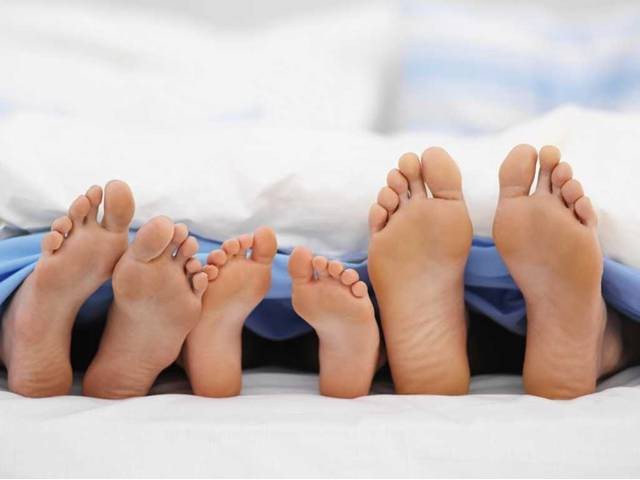
Some pathologies can be indicators of various serious diseases. If you pay attention to foot development in time, you can prevent many serious problems. Genetic abnormalities are almost impossible to correct, but modern medicine is quite capable of controlling them.
How to tell if your shoes are too small
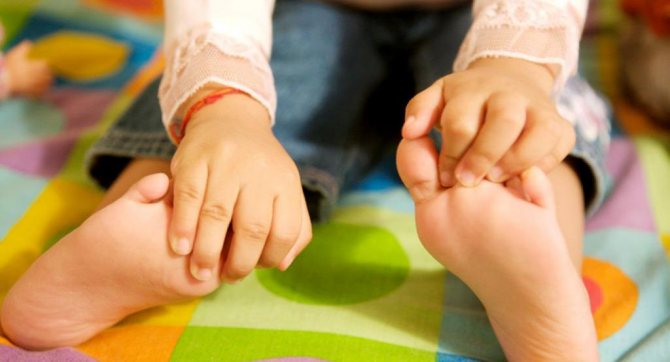
The easiest way to find out that a child has outgrown the shoe is to take out the insole from that same shoe and place the baby’s foot on it. If the margin remains less than 5 mm, then it’s time to change the size.
But not everywhere there is access to the insole; in some places it is glued in, in others it is stitched together with the sole. Don't despair. You need to put shoes on the child and press on the toe, if there is a small dent, the space is not filled and there is a reserve.
If the toes of the shoes are hard and it is not possible to check whether there is a reserve in this way, you need to outline the baby’s foot on cardboard, make an improvised insole, and insert it into the shoes. This way you can determine whether there is a supply or whether it is worth changing the shoes for another pair. How to determine the size of children's shoes was described above.
How to choose for kids
A special table of children's shoe sizes by age in centimeters (cm) will allow you to decide on suitable shoes for babies 0-3 years old.
| Baby's age in months | Foot length(cm) | Size chart | ||
| European/Russian | American | English | ||
| 0-3 | 9,5 | 16 | 1 | 0 |
| 3-6 | 10-10,5 | 16,5-17 | 1,2-2 | 0-1 |
| 6-12 | 11-11,5 | 18-19 | 2,5-3 | 1,5-2,5 |
| 12-18 | 12-12,5 | 19,5-20 | 4-5 | 3-4 |
| 18-24 | 13,5-14 | 21-22 | 5,5-6,5 | 4,5-5,5 |
| 24-30 | 14,3-14,7 | 23-24 | 7-8 | 6-7 |
| 30-36 | 14,7-15,6 | 24-25 | 8-8,5 | 7-8 |
